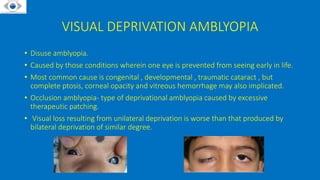Amblyopia, commonly known as lazy eye, is a unilateral or bilateral vision impairment in children due to visual deprivation or abnormal binocular interaction, and is the leading cause of preventable vision loss in this demographic. The condition is influenced by factors such as premature birth, neurological issues, and refractive error, and can be classified into types including strabismic, anisometropic, and deprivation amblyopia. Treatment options include optical correction, occlusion therapy, penalization, and in some cases, pharmacological and surgical interventions, with ongoing research highlighting the importance of binocular development and maintenance therapies post-treatment.












































